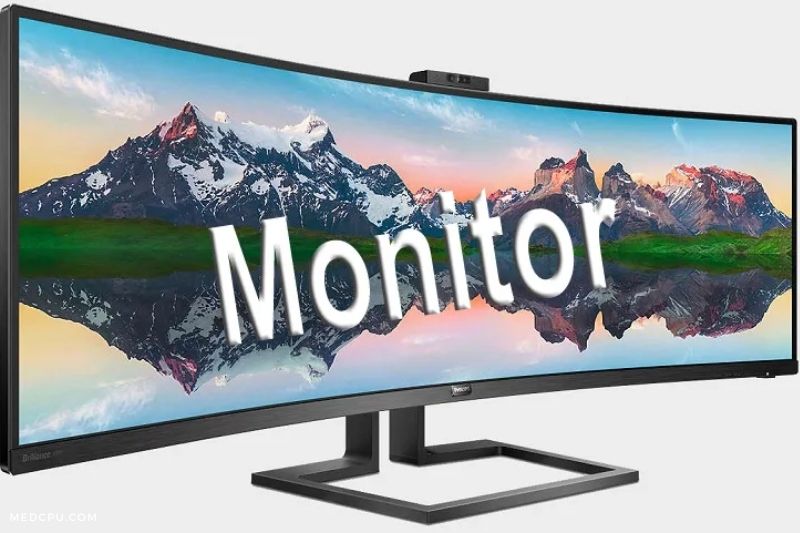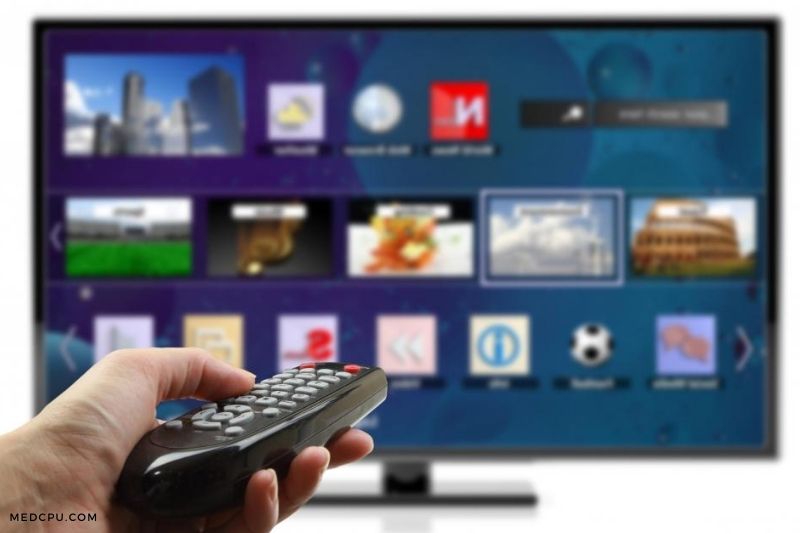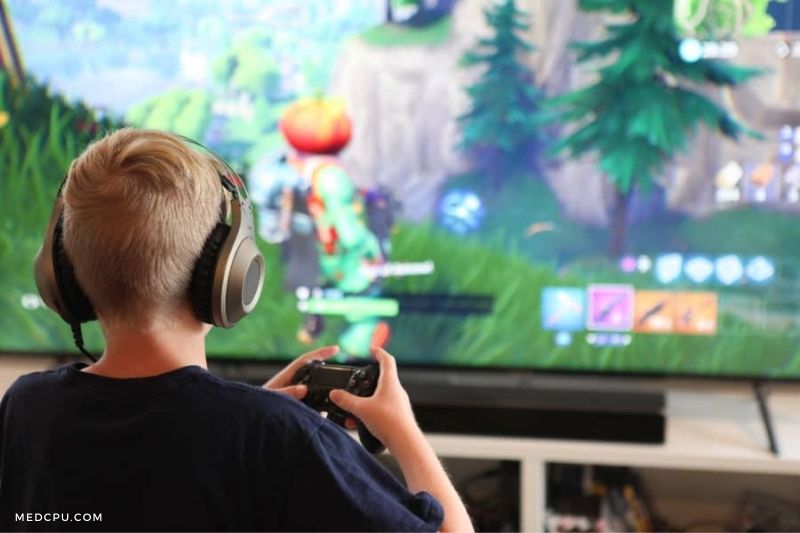TV vs Monitor are two different devices with the same main purpose, to display images and videos. A difference in design and technology in each has to lead to each having its own pros and cons in fields such as home entertainment and production in fields such as gaming and video editing.
Choosing a TV over a monitor can be quite a hard decision to make. We all know TVs and monitors have different technical specifications that determine their pros and cons. To help, MedCPU will outline some of the differences in this article. Let’s dive in!
What is Monitor?
The computer monitor is an output device that displays information in visual form. It is an essential part of any computer system. It allows users to understand better what is happening on their computers and helps them manage their actions and commands better.
Computer monitors were initially used to process data. Later, they were also used for entertainment. Visual Display Units, or VDU, was the term used to refer to computer monitors. However, it was eventually dropped.

Since its inception, many modern features have been added to computer monitors. The latest generation of monitors uses a power-saving mode. These monitors also come with indicator lights to indicate the presence of different modes. Many accessories can be integrated. Touch screen monitors with ultra-wide screens are also available.
The monitors also have many professional features such as anti-glare, anti-reflection, directional screens, and tablet screens. There are many types of monitors, including desktop monitors. They can be distinguished based on the type and style of mounting they have.
What is TV?
Television, also known as TV, is an electronic device that’s used for audiovisual entertainment purposes. There are many types of television sets. The user chooses the sets based on their preference and convenience. Televisions provide entertainment and a wide range of content.
Television transmits monochrome and colored moving pictures. Nearly 80% of households around the globe owned a TV set as of 2019. Television broadcasts a variety of media content, and television is used as an entertainment source. There are many other names for television sets.

Television sets are also called telly or television. There are many types of television sets. They can be distinguished based on different parameters. Televisions are classified according to their technology, screen type, resolution, features, and other parameters. There are many improvements to the various types of televisions.
There are many types to choose from: a quantum light-emitting diode, an organic light-emitting dime display, LED TVs and LCDs or liquid crystal displays, LED TVs and plasma panels, direct TVs, flat and curved televisions at 720p and 1080p, 4k, and 8k resolutions televisions, smart TVs, high-dynamic-range televisions with voice activation, and smart televisions.
TV vs Monitor Comparison
Screen Size
The size of the monitor is the most noticeable difference between a TV and a monitor.
Monitors are now available in a range of sizes, from 21 to 32 inches. However, the majority of them fall within the 24-27 inch range. They are generally between 32 and 65 inches in size, but smaller and larger options are also available.
A bigger screen is more comfortable for you to use games and other content while sitting further away. It can make split-screen multiplayer more enjoyable.
You’ll notice a difference if you use a monitor at work. Most people agree that larger monitors than 27 inches are uncomfortable to use close up, but this depends on the aspect ratio. A large screen does not always mean a high-quality one. That’s why resolution is essential.
Image Quality and HDR
Modern TVs offer either 1080p or 4K resolution, with the addition of 8K. Monitors are more versatile, offering 1080p and 1440p as well as 4K.
Televisions tend to be more concerned with picture quality and raw viewing experience. Gaming monitors, on the other hand, try to balance specifications wherever they can. Sometimes, this means sacrificing one area to save money. IPS monitors are becoming less popular because they offer better color accuracy and responsiveness.
HDR is almost unbeatable if you consider HDR. While HDR is becoming more popular in the gaming monitor world, TVs still provide this feature more frequently. You should also know that most of your content does not have HDR support if you are playing on a PC, but PS4 Pro, Xbox One S, and Xbox One X do.
It’s not surprising that so many gamers are switching from TV to monitor due to the increasing HDR support and IPS panels which provide better color reproduction and viewing angles.
Resolution
It can be challenging to decide whether TVs have better resolution than gambling monitors. There are many options.
The majority of gambling screens are in the 1080p and even 1440p settlement ranges. These settlements provide a remarkable balance of quality and detail when viewed up close. They also offer smooth complete functionality.
Televisions, however, are a different story due to their pixel density.
Input Lag
Many gamers have found that games on large flatscreen HDTVs are nearly impossible to play since the switch from CRT screens to flatscreen HDTVs. Large HDTVs now use dedicated graphics processing hardware that can handle higher-resolution signals. This makes images appear cleaner and smoother.
CRTs were not affected by this issue and are still preferred by gamers (e.g., Melee players) who wish to reduce input lag.
Monitors don’t need to use a Game Mode to reduce input latency. They perform better across the board in this category. Monitors are better than TVs at reducing input latency due to the presence of 144hz and 240hz monitors.
The numbers show that most monitors are between 1ms and 5ms. However, some smaller, more expensive, or IPS-based displays are faster. TVs start at 5ms, but then climb up, sometimes reaching 20ms. Although it’s less well-known, built-in Game Modes can help with this in varying degrees. However, the numbers confirm that TVs are slower.
Read also 24 Vs 27 Monitor 2022: https://medcpu.com/24-vs-27-monitor/
Refresh Rates

A display’s refresh rate is another factor that can affect its performance. The refresh rate refers to how often a display refreshes or redraws its image every second. Modern displays can display 60Hz refresh rates, which means that they refresh their image 60 times per second.
You’ve likely also seen high-end gaming monitors or HDTVs advertised at higher refresh rates, such as 120Hz, 144Hz, or 240Hz. However, this can be misleading as a computer monitor that refreshes at 120Hz may differ from an HDTV that refreshes at 120Hz.
This is because television content is produced at a variety of frame rates. A computer monitor can show content at very different frame rates. Many games can produce frames rates up to 60fps if you have a strong enough graphics card.
An HDTV that advertises a fast refresh rate might use post-processing technology. This could include adding additional frames to enhance content or black frames between frames to prevent blurring.
This won’t matter if you aren’t playing PC games at high frame rates. If you want to maximize your gaming experience, an HDTV monitor is a better option than a computer monitor.
Response Time
It is sometimes confused with input lag. Response time is the time it takes for a display’s pixels to change colors between scenes. There can be very different response times between HDTVs, computer monitors, and other types of HDTVs.
HDTVs are more likely to display richer colors and have higher contrast. They also offer wider viewing angles, which can lead to a slower response time.
For faster response times, computer monitors often drop some image processing and viewing angles. You may experience ghosting when watching fast-paced video or gaming sequences on a monitor with a slower response speed.
A few HDTVs include a game mode setting that reduces image processing in order to increase input lag and response times. You should check the options on your HDTV to find out if this feature is available if you intend to play PC games.
Adaptive-Sync
Some monitors have variable refresh rates or adaptive-sync features such as AMD FreeSync or Nvidia G–SYNC.
You will need a compatible graphics card to use adaptive-sync technology. This allows you to choose from different refresh rates to eliminate screen stuttering or screen tears.
A gaming monitor with FreeSync technology, 120Hz or higher refresh rates, and FreeSync technology will work well if you play PC and console games. You can also find TVs with FreeSync technology and variable refresh rates that are ideal for all gaming.
HDR
A 4K TV with a high price tag should have an HDR (High Dynamic Range) feature. This allows for better images and a more natural experience.
HDR also allows for more excellent contrast between the most bright whites and deepest blacks. You can take your gaming to the next level by increasing the contrast.
You can quickly see the enemy hidden in dark corners with better contrast and take the appropriate action.
Comfort
Let’s now talk about relaxation. This will be tested on both the viewing angles and seeing space.
Viewing distance
The TV’s larger size makes it easier to use your couch or bed for gaming. This advantage is only amplified the bigger your screen gets. Because of their smaller dimensions, it is easier to stay closer to your screen. You won’t feel as comfortable sitting at a desk if you don’t have the money to buy a gaming chair.
PC gamers don’t have to sit at a desk. The additional benefits of responsiveness make this a non-issue.
Viewing Angles
TVs have great viewing angles that allow you to choose from a wide range of seating options in your living room. IPS monitors are more expensive than TN monitors and offer better viewing angles, but they aren’t worth serious gamers’ costs. Televisions offer large viewing angles and are bigger than other monitors.
TVs have the advantage of having a wider viewing angle than monitors. However, once you start a match, you will be able to see everything from your TV. This makes a great viewing angle useless for individual events.
OLED
OLED displays do not have backlighting, so they can respond instantly to pixel changes and offer infinite contrast ratios.
OLED monitors are not suitable for gaming or everyday use. OLED monitors are available in a few models, but they can be costly.
OLED TVs are too large for PC gamers (48 inches or more).
An OLED TV is required if you are looking for an OLED display. An OLED TV, such as the LG CX with OLED technology, is highly recommended. The monitor supports native 4K 120Hz through NVIDIA G–SYNC or AMD FreeSync technology.
Price
When buying a new monitor or TV, price is the essential factor. Monitors can be more affordable depending on your budget. The TV is a better value if you want more features and powerful performance.
If you want a better viewing experience and more value, then a TV is the best choice. However, if your budget allows for decent viewing, then monitors are a better choice.
It all depends on what you need and how much money you have. You should ensure that the display you plan to buy has a good value for money and delivers decent performance.
FAQs

Can I use the TV as a monitor?
You can use a TV as a monitor to view photos or videos on, but you may need an HDMI cable to connect it to your computer. TVs are a type of monitor, but they’re usually used as a big screen for entertainment. If you want to use a TV as a monitor, you’ll need to use an HDMI cable to connect it to your computer.
Does a monitor make a difference for gaming?
A monitor can make a difference for gaming, as it is important to have the best display that will provide the best viewing angle, color, and resolution.
The difference that a monitor can make for gaming is that it offers many different advantages when it comes to games. This includes providing the best viewing angle, having the right color, and having the best resolution. These are all important because they help the player see what is going on in the game much better.
Why do pro gamers use small monitors?
Their monitors are small so that they can see the game better. The smaller screens allow for better focus on the game, which is beneficial to the competitive players.
A pro gamer needs to be able to see what is going on the screen to play the game correctly. It is very important that pro gamers use monitors with smaller screens so that they can play better in order to win.
Conclusion
A TV is much larger and consumes much more power than a monitor. The TV is not as versatile as a monitor and is not very good for watching movies, but is excellent for gaming and sports events. TVs are becoming much better and affordable now. However, there is a very wide range of prices and specs.
A monitor is a much more powerful tool for productivity and design but lacks the size of a TV. It consumes much less power and provides better viewing angles. It’s a great tool for designers and creators as well as a great option for a secondary screen for a PC. It also isn’t as big as a TV.
Thanks for reading and best of luck to you!
Video:

Eyal Ephrat serves as the co-founder and CEO of medCPU.com, where technology is making significant strides in the field of medicine. Through his experience in purchasing PC and laptop equipment and various other tech products, Eyal Ephrat contributes valuable insights to medCPU’s mission.
